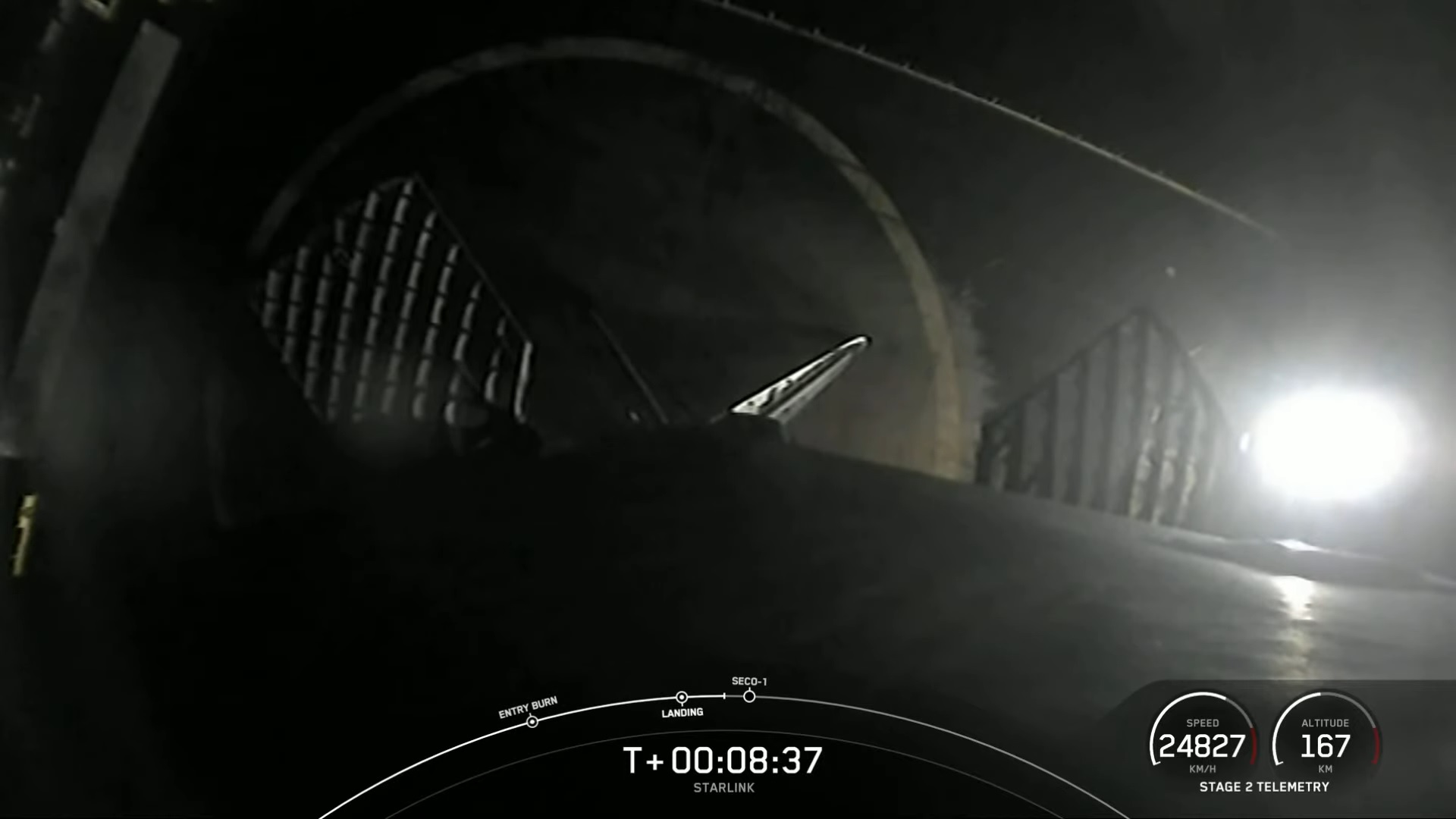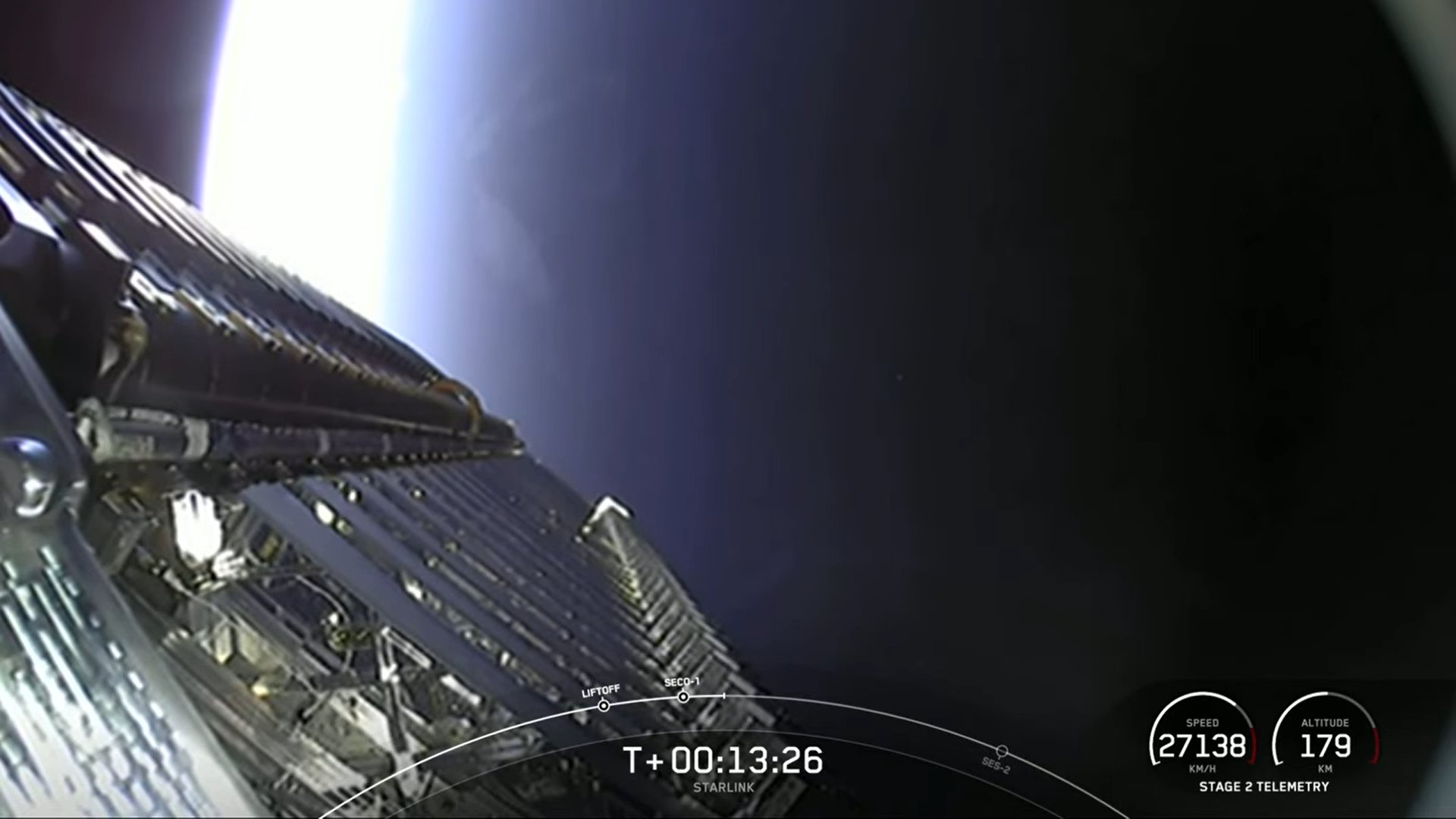SpaceX launches 60 new Starlink internet satellites, nails latest rocket landing at sea
There are now more than 1,300 Starlink satellites in orbit.
CAPE CANAVERAL, Fla. — A SpaceX Falcon 9 rocket launched a new batch of 60 Starlink internet satellites into orbit early Wednesday (March 24) and nailed a landing at sea to top off the company's latest successful mission.
The veteran Falcon 9 rocket blasted off from Space Launch Complex 40 here at Cape Canaveral Space Force Station in Florida at 4:28 a.m. EDT (0828 GMT).
Approximately nine minutes later, the reusable rocket's first stage returned to Earth for its sixth successful landing. SpaceX's drone ship "Of Course I Still Love You" was stationed out in the Atlantic Ocean, standing by for the catch.
Related: SpaceX's Starlink satellite megaconstellation launches in photos

Join the Space.com forums here to discuss SpaceX and space travel. Let the community know what you're thinking!
Today's flight is the fourth Starlink mission this month for the Hawthorne, California-based rocket builder. SpaceX is inching closer to filling its initial internet constellation, which is planned to be 1,440 strong. Eventually that constellation could be tens of thousands of satellites strong as SpaceX has permission to launch as many as 30,000, with an option for even more.
It was a slightly cloudy morning in Florida as the Falcon's flames lit up the night sky. Weather forecasters at the 45th Weather Squadron predicted ideal conditions for launch, with the only weather concerns being the potential for cumulus clouds. Mother nature did not disappoint
"This is the sixth landing for this booster and the 78th landing overall," Andy Tran, a production supervisor at SpaceX, said on the launch webcast. "What a way to start the day."
Get the Space.com Newsletter
Breaking space news, the latest updates on rocket launches, skywatching events and more!
The launch occurred on the 15th anniversary of SpaceX's first-ever launch, an unsuccessful flight of its first Falcon 1 rocket, Tran said.
"With more than 100 successful flights of Falcon 9 and 78 recoveries of our first stage to date, we've made a lot of progress since then," he added.
Related: Brilliant SpaceX rocket launch sparks fireball reports
Sixth flight's a charm

The booster for today's launch, called B1060, is one of six Falcon 9 boosters in SpaceX's fleet of flight-proven rockets. The veteran flier now has six flights under its belt, including four different Starlink missions. In addition, the booster also lofted an upgraded GPS III satellite for the U.S. military in June 2020, and a communications satellite for Turkey in January of this year.
In fact, this was the first rocket that the U.S. military allowed SpaceX to recover, a switch from its previous military launches where the company would discard the booster after it delivered its payload. NASA recently followed suit, permitting SpaceX to reuse its rockets on crew missions. The upcoming Crew-2 mission, set to launch no earlier than April 22, will be the first crewed flight to fly on a refurbished rocket. (That mission will also feature a reused Crew Dragon spacecraft.)
Wednesday's launch marks the ninth flight overall for SpaceX in 2021, and the third flight this year for this particular booster. Its last flight took off on Feb. 4, and engineers spent just under 50 days getting it prepped and ready to fly again.
Having a fleet of flight-proven rockets at its disposal, allows SpaceX to keep up with its rapid launch cadence. However company officials have stressed that while booster recovery is a bonus, the main objective is to deliver whatever payload the rocket is carrying to space.
This is the 112th overall flight for Falcon 9, and the 58th reflight of a booster. In fact every single launch so far in 2021 for SpaceX has been on a flight-proven rocket. It also marks the fourth successful landing in a row for SpaceX, after the company lost one of its six-time fliers on Feb. 15 when the rocket lost an engine during flight and subsequently failed to land on the drone ship.
SpaceX has since attributed the anomaly to a worn out engine cover that allowed hot gases to seep into places they weren't supposed to. This caused one of Falcon 9's engines to shut down during flight. The rocket is designed to be able to complete its mission even if it loses an engine, but it was unable to slow itself enough to touchdown on the drone ship, and instead landed in the ocean.
An upgraded version of Falcon 9 debuted in 2018, and the company boasted that it expected each Falcon 9 first stage could fly an estimated 10 times with little-to-no refurbishments in between, and as many as 100 times before retirement.
One of SpaceX's other boosters is very close to achieving that milestone as it hit its ninth launch and landing last week. B1051, is the fleet's leader and could blast off on its historic flight in the near future.
Constellation competition
With tonight's launch success, SpaceX has launched more than 1,300 Starlink satellites into orbit, which includes some that are no longer operational. And there are many more launches coming as SpaceX's initial Starlink constellation will consist of 1,440 satellites. However, the company has sought approval for tens of thousands more.
The company launched its massive constellation, with one major goal: to connect the globe. To that end, SpaceX designed a fleet of flat paneled broadband satellites that will fly over the Earth, providing users across the globe with internet coverage. In particular those in rural and remote areas who otherwise would not have connectivity.
Starlink review (hands on): How good is Elon Musk's satellite internet service?

Currently Starlink is still in beta-testing as SpaceX works to fill out its initial constellation. Users in the U.S., Canada, the U.K., Germany and now New Zealand can access the service. SpaceX is taking preorders for when it rolls out full commercial services sometime later this year.
Users can reserve the service with a $99 deposit, by signing up on the company’s website.
SpaceX is not the only company with aspirations of connecting the globe. OneWeb, a London-based company, is preparing for a launch of its own. If all goes as planned, late Wednesday (US time), a Russian Soyuz 2.1b will carry 36 OneWeb satellites to space. The company launched its most recent mission in December.
OneWeb has a total of 19 flights planned, which will deposit a total of 650 internet-beaming satellites into space. And has launched five of those flights to date. (Amazon and Telstar also have constellations planned but have yet to launch any hardware.)
Falling fairings
SpaceX's newest boat, the Shelia Bordelon, made its debut this morning as she pulled the rocket's payload fairings out of the water. Fleet watchers were all a buzz as the boat, painted bright pink and blue, sailed into Port Canaveral last week and parked at the SpaceX docks.
It's unclear if this boat will be a permanent member of the fleet or if the ship is just helping out short term. GO Ms. Chief and GO Ms. Tree have been sidelined for several missions now, as SpaceX has turned to its Crew Dragon recovery vessels to scoop the fairings out of the ocean. Those boats are going to have to return to Dragon duties as the next crew mission is quickly approaching.
Both of the fairing halves have flown before, and with any luck, they will fly again soon.
Follow Amy Thompson on Twitter @astrogingersnap. Follow us on Twitter @Spacedotcom or Facebook.
Join our Space Forums to keep talking space on the latest missions, night sky and more! And if you have a news tip, correction or comment, let us know at: community@space.com.

Amy Thompson is a Florida-based space and science journalist, who joined Space.com as a contributing writer in 2015. She's passionate about all things space and is a huge science and science-fiction geek. Star Wars is her favorite fandom, with that sassy little droid, R2D2 being her favorite. She studied science at the University of Florida, earning a degree in microbiology. Her work has also been published in Newsweek, VICE, Smithsonian, and many more. Now she chases rockets, writing about launches, commercial space, space station science, and everything in between.









